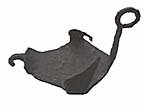
While I was skimming abstracts of different news items this week, I noticed
a statement that Romans invented the game of horseshoes. It got me to
wondering about when horseshoes were developed. I found this interesting
reference to the first horseshoes called "hipposandals" by the Romans that
were tied on.
"Sometime after the first century, horses with shod hooves traversed the
roadways set down by ancient Romans. To protect their valuable steeds,
riders outfitted their horses with coverings inspired by the sandals
strapped to their own feet. These leather and metal "hipposandals" fitted
over horses' hooves and fastened with leather straps."
"In the colder, damper climates of northern Europe, however, horses were
used in farming and had trouble gaining a toehold on the surface. Horsemen
tried various remedies, and by the 6th & 7th centuries began nailing metal
shoes onto their horses' hooves."
Armed with the term "hipposandal", I continued my research and found this
picture of an early "hipposandal".
I guess it should not be a surprise that the Romans developed such
protection for the feet of their horses since their animals were used
extensively on all of those paved Roman roads!
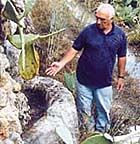 "What could be part of an olive press dating back to Roman times has been discovered embedded under a high rubble wall on the outskirts of Nadur.
"What could be part of an olive press dating back to Roman times has been discovered embedded under a high rubble wall on the outskirts of Nadur.
 While I was skimming abstracts of different news items this week, I noticed
While I was skimming abstracts of different news items this week, I noticed
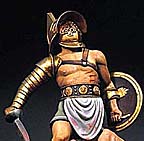 The largest collection of gladiator inscriptions known outside Rome have been discovered in an amphitheater in Cordoba. An archaeology professor at the University of Cordoba, Desiderio Vaquerizo said the amphitheater could hold up to 50,000 people. It is the third largest after the Colloseum in Rome and the amphitheater in the ancient Tunisian city of Carthage.
The largest collection of gladiator inscriptions known outside Rome have been discovered in an amphitheater in Cordoba. An archaeology professor at the University of Cordoba, Desiderio Vaquerizo said the amphitheater could hold up to 50,000 people. It is the third largest after the Colloseum in Rome and the amphitheater in the ancient Tunisian city of Carthage.
 Al-Jouf, first mentioned in recorded history in the royal Annals of Assyria, when it was attacked by the Assyrian King Sennacherib in 688 BC, is the site of a discovery of Roman coins. The coins were unearthed on a hillside a few kilometers behind the Aramco oil terminal outside Sakaka. The regional capital of the northern province of Al-Jouf, Sakaka contains Saudi Arabia’s equivalent of Stonehenge. The cluster of sandstone stele, known as Al-Rajajil, have stood here for more than 6,000 years. Standing astride the trade routes from Syria and Iraq to Yemen, Syrian, Roman and Greek artifacts have all been found here.
Al-Jouf, first mentioned in recorded history in the royal Annals of Assyria, when it was attacked by the Assyrian King Sennacherib in 688 BC, is the site of a discovery of Roman coins. The coins were unearthed on a hillside a few kilometers behind the Aramco oil terminal outside Sakaka. The regional capital of the northern province of Al-Jouf, Sakaka contains Saudi Arabia’s equivalent of Stonehenge. The cluster of sandstone stele, known as Al-Rajajil, have stood here for more than 6,000 years. Standing astride the trade routes from Syria and Iraq to Yemen, Syrian, Roman and Greek artifacts have all been found here.
 "They thought it had been made by skilled local craftsman in the last century before the Roman invasion. But scientific analysis of an Iron Age gold hoard found near Winchester in 2000 showed it was made by Roman or Hellenic craftsman between 70BC and 30BC," said Dr. Dick Whinney, curator of the British Museum.
"They thought it had been made by skilled local craftsman in the last century before the Roman invasion. But scientific analysis of an Iron Age gold hoard found near Winchester in 2000 showed it was made by Roman or Hellenic craftsman between 70BC and 30BC," said Dr. Dick Whinney, curator of the British Museum.
 I have always loved the Greco-Roman mummy portraits from the Fayum region of Egypt and today stumbled across this wonderful site about them. Discovered in March, 1888 by Flinders Petrie, the site was termed 'an immense cemetery of Roman time with rooms brick-built tombales still containing the bodies of their owners'. He became quite emotional when he gazed on the first portrait still fixed to its mummy, 'a splendidly drawn girl, with sweet grey tints'. "
I have always loved the Greco-Roman mummy portraits from the Fayum region of Egypt and today stumbled across this wonderful site about them. Discovered in March, 1888 by Flinders Petrie, the site was termed 'an immense cemetery of Roman time with rooms brick-built tombales still containing the bodies of their owners'. He became quite emotional when he gazed on the first portrait still fixed to its mummy, 'a splendidly drawn girl, with sweet grey tints'. "
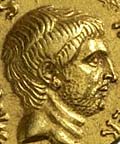 Archaeologists digging at the ancient city of Antikythera have located sanctuaries, a large public building and a wealth of missiles — spear and arrow heads, slingshots and large catapult stones — in the settlement identified as the city of Aegila mentioned in ancient sources. Antikythera controlled the strait between Kythera and western Crete, a crucial passage for shipping.
Archaeologists digging at the ancient city of Antikythera have located sanctuaries, a large public building and a wealth of missiles — spear and arrow heads, slingshots and large catapult stones — in the settlement identified as the city of Aegila mentioned in ancient sources. Antikythera controlled the strait between Kythera and western Crete, a crucial passage for shipping.
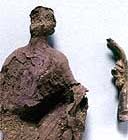 "Senua, a previously unknown Romano-British goddess, has been resurrected at the British Museum, patiently pried from soil-encrusted clumps of gold and corroded silver which have buried her identity for more than 1,600 years."
"Senua, a previously unknown Romano-British goddess, has been resurrected at the British Museum, patiently pried from soil-encrusted clumps of gold and corroded silver which have buried her identity for more than 1,600 years."
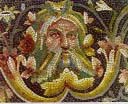 "New mosaics and frescos have been excavated from the ancient city of Zeugma located in Belkis Village 10 km east from Nizip town of southeastern Gaziantep province, by the River Euphrates."
"New mosaics and frescos have been excavated from the ancient city of Zeugma located in Belkis Village 10 km east from Nizip town of southeastern Gaziantep province, by the River Euphrates."
 Five gold coins minted in Constantinople and a gold bracelet decorated with nine crosses have been unearthed by Hungarian archaeologists excavating a necropolis 45 kilometers west of Alexandria.
Five gold coins minted in Constantinople and a gold bracelet decorated with nine crosses have been unearthed by Hungarian archaeologists excavating a necropolis 45 kilometers west of Alexandria.
 Dr Jerome Eisenberg, editor-in chief of ancient art and archaeology magazine Minerva, states in a recent issue that he is convinced that the Portland Vase, one of the most famous cameo-glass vessels from antiquity, was created during the Renaissance. It was thought to have been found in the tomb of Emperor Severus Alexander in 1582.
Dr Jerome Eisenberg, editor-in chief of ancient art and archaeology magazine Minerva, states in a recent issue that he is convinced that the Portland Vase, one of the most famous cameo-glass vessels from antiquity, was created during the Renaissance. It was thought to have been found in the tomb of Emperor Severus Alexander in 1582.